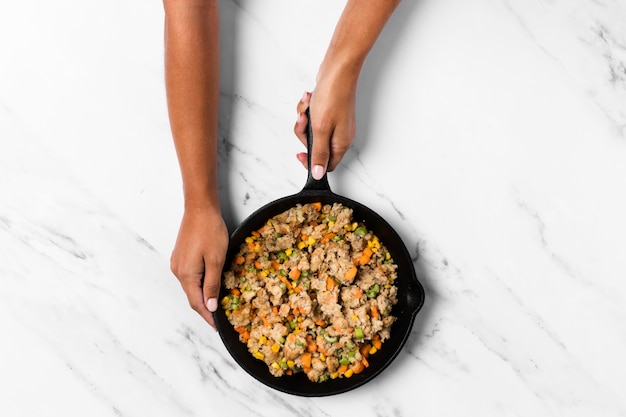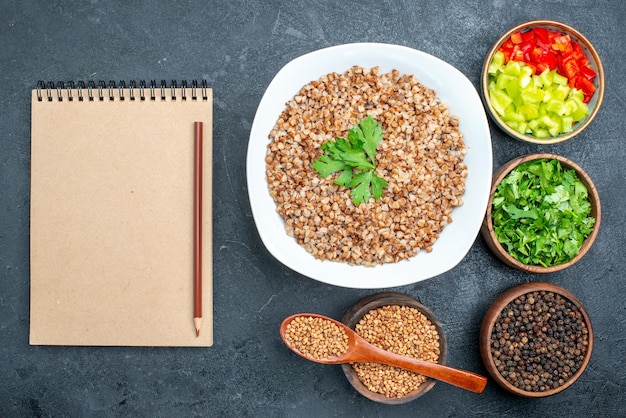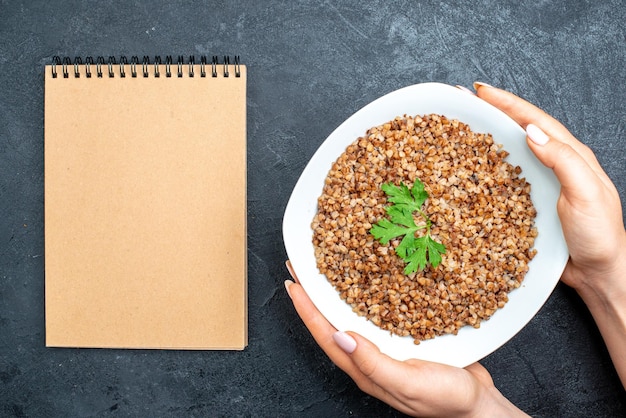Let's face it: quinoa is everywhere these days. And for good reason! This tiny, nutty grain is a nutritional powerhouse, bursting with protein, fibre, and all sorts of other goodies. It's also incredibly versatile, making it a star in everything from salads and bowls to veggie burgers and even desserts.
But here's the thing: cooking quinoa can be a little tricky. Get it wrong, and you're left with a mushy, sticky mess. Get it right, and you've got a fluffy, delicious base for all your culinary creations.
So, let's dive into the world of quinoa together! I'm going to share everything I've learned about cooking this amazing grain, from the very basics to some more advanced techniques. This is your one-stop shop for mastering the art of quinoa, whether you're a seasoned cook or just starting out.
(Part 1) The Basics: What You Need to Know

1. Choosing the Right Quinoa
You'll find a few different types of quinoa at the supermarket, each with its own unique flavour and texture:
White quinoa: This is the most common type, with a mild, nutty flavour. It cooks quickly and has a light, fluffy texture, making it perfect for a wide range of dishes.
Red quinoa: This variety has a slightly earthier flavour and a chewier texture than white quinoa. It's often used in salads and grain bowls where its slightly firmer bite adds a nice contrast.
Black quinoa: This quinoa has a slightly bitter flavour and a slightly crunchy texture. It's often used in salads and as a garnish, adding visual interest and a bit of a textural surprise.
You can experiment with different types to see which you prefer, but for a beginner, white quinoa is a great place to start. It's versatile and easy to work with.
2. How to rinse quinoa
Rinsing quinoa is a crucial step, even though many people skip it. This simple action prevents bitterness and ensures a fluffy texture.
Why rinse? Quinoa naturally has a bitter coating called saponin. This coating helps protect the quinoa plant in its natural environment, but it's not exactly pleasant to eat. Rinsing removes the saponin, leaving you with a delicious, flavourful grain.
To rinse quinoa, simply:
1. Place the quinoa in a fine-mesh sieve. I like to use a sieve with small holes to make sure I remove all the saponin.
2. Rinse it thoroughly under cold running water. Hold the sieve under the tap and let the water flow through the quinoa for about 30 seconds.
3. Gently shake the sieve to remove any excess water. You want the quinoa to be free of excess moisture before cooking.
3. The Perfect Ratio
The golden ratio for cooking quinoa is 1 part quinoa to 2 parts liquid. This ratio ensures that the quinoa is cooked through but not overcooked.
You can use a measuring cup, a saucepan, or even a pot to measure out your quinoa and liquid. Just make sure your cookware is large enough for the quinoa to expand as it cooks.
4. The Best Liquid
You can use water to cook quinoa, but I find that using broth adds a delicious flavour boost. Chicken or vegetable broth are excellent choices, and you can get creative with different flavours. For a richer, creamier flavour, I love adding a splash of coconut milk.
Experiment with different liquids to discover your favourite combinations.
5. The Cooking Method
There are two main ways to cook quinoa: on the stovetop and in a rice cooker. Both methods are straightforward, but I prefer the stovetop method because it gives me more control over the cooking process.
Stovetop Method
1. Combine the rinsed quinoa and your chosen liquid in a saucepan. Make sure the saucepan is large enough for the quinoa to expand as it cooks.
2. Bring the mixture to a boil over medium heat. You'll know it's boiling when bubbles start to appear and rise rapidly to the surface.
3. Reduce heat to a simmer, cover the pot, and cook for 15-20 minutes, or until the liquid is absorbed and the quinoa is fluffy. Keep an eye on the pot and make sure the liquid doesn't completely evaporate.
4. Remove from the heat and fluff the quinoa with a fork. This helps to separate the grains and prevent them from sticking together.
Rice Cooker Method
1. Rinse the quinoa as usual.
2. Place the quinoa in the rice cooker along with your chosen liquid, following the manufacturer's instructions. Most rice cookers have a specific setting for cooking quinoa.
3. Close the lid and press the "cook" button. The rice cooker will do the rest of the work, automatically turning off when the quinoa is cooked.
4. Once the rice cooker signals that the quinoa is cooked, fluff it with a fork.
(Part 2) Mastering the Art of Fluffiness

1. The Secret to fluffy quinoa
So, you've cooked the quinoa, but it's still a bit sticky. What happened? Quinoa releases starch as it cooks, and if you don't give it enough room to breathe, that starch can clump together and make the quinoa mushy.
Here are a few tips to ensure a perfectly fluffy quinoa:
Don't overcrowd the pot: Make sure there's enough space for the quinoa to expand as it cooks.
Don't stir too much: Stirring too much can break down the quinoa and make it sticky. Let it cook undisturbed until the liquid is absorbed.
Fluff it after cooking: Fluffing the quinoa with a fork helps to separate the grains and create a light, fluffy texture.
2. The Importance of Resting
Another crucial step to achieving perfect quinoa is allowing it to rest after cooking. Cover the pot and let it sit for 10 minutes. This allows the quinoa to fully absorb the liquid and create a beautifully fluffy texture.
3. The Art of Timing
Cooking quinoa is a bit of a delicate dance. Overcooked quinoa will be mushy, and undercooked quinoa will be hard and crunchy. The perfect quinoa is cooked through but still retains a slight bite.
Check the quinoa early: Don't just blindly assume it's done after 15-20 minutes. Start checking around the 15-minute mark.
Taste test: The best way to tell if the quinoa is done is to taste it. It should be tender but not mushy.
If you find that the quinoa is still too firm, add a little more liquid and continue cooking for a few more minutes.
(Part 3) Quinoa Beyond the Basics

1. Adding Flavour
The beauty of quinoa is that it's a blank canvas for flavour. I love experimenting with different herbs, spices, and ingredients to create unique dishes.
Here are a few ideas to get you started:
Herbs: Fresh herbs like parsley, cilantro, mint, basil, and chives add a burst of freshness and flavour to quinoa.
Spices: Ground cumin, coriander, turmeric, paprika, and cayenne pepper can add depth and warmth to quinoa.
Vegetables: Sautéed onions, garlic, peppers, mushrooms, and spinach bring a wonderful depth of flavour and texture to quinoa dishes.
Nuts and seeds: Toasted nuts and seeds like almonds, walnuts, pumpkin seeds, and sunflower seeds add a satisfying crunch and nutty flavour to quinoa.
Citrus: A squeeze of lemon or lime juice brightens up the flavour of quinoa and adds a refreshing tang.
2. quinoa salads
Quinoa salads are a delicious and healthy meal or side dish. They're easy to make and can be customized to your liking.
Here's a simple recipe for a quinoa salad:
Ingredients:
1 cup cooked quinoa
1 cup chopped cucumber
1/2 cup chopped red onion
1/4 cup chopped fresh parsley
1/4 cup crumbled feta cheese
2 tablespoons olive oil
1 tablespoon lemon juice
Salt and pepper to taste
Instructions:
Combine all the ingredients in a large bowl and toss to coat.
Refrigerate for at least 30 minutes before serving.
This salad is refreshing and full of flavour, perfect for a light lunch or a healthy side dish. Feel free to get creative with the ingredients and add your own favourite vegetables, fruits, and cheeses.
3. quinoa bowls
Quinoa bowls are another great way to enjoy quinoa. They're perfect for a quick and easy lunch or dinner.
Here's a recipe for a quinoa bowl:
Ingredients:
1 cup cooked quinoa
1/2 cup roasted vegetables (like sweet potatoes, broccoli, or cauliflower)
1/4 cup black beans
1/4 cup diced avocado
1 tablespoon salsa
1/4 cup chopped cilantro
1 tablespoon lime juice
Salt and pepper to taste
Instructions:
Combine all the ingredients in a bowl and serve immediately.
This bowl is packed with flavour and nutrients, offering a delicious and satisfying meal. You can customize it with different vegetables, beans, sauces, and toppings to suit your preferences.
(Part 4) Quinoa in Desserts
Who said quinoa couldn't be sweet? This versatile grain is fantastic for desserts, too!
1. Quinoa Pudding
Quinoa pudding is a delicious and healthy alternative to traditional rice pudding. It's creamy, comforting, and full of flavour.
Here's a recipe for quinoa pudding:
Ingredients:
1 cup cooked quinoa
1 cup milk (cow's milk, almond milk, or coconut milk)
1/4 cup sugar
1/4 teaspoon vanilla extract
Pinch of salt
Instructions:
In a saucepan, combine the milk, sugar, vanilla extract, and salt.
Bring to a simmer over medium heat, stirring constantly.
Stir in the cooked quinoa and continue to cook for 5-10 minutes, or until the pudding thickens.
Serve warm or cold.
This pudding is a delightful way to enjoy quinoa for dessert. You can add toppings like chopped nuts, fruit, or a drizzle of honey for extra flavour and texture.
2. Quinoa Cookies
Believe it or not, quinoa can even be used to make cookies! These cookies are chewy, nutty, and surprisingly delicious.
Here's a recipe for quinoa cookies:
Ingredients:
1 cup cooked quinoa
1/2 cup butter, softened
1/2 cup sugar
1/4 cup brown sugar
1 egg
1 teaspoon vanilla extract
1 1/4 cups all-purpose flour
1/2 teaspoon baking soda
1/4 teaspoon salt
Instructions:
Preheat oven to 375 degrees F (190 degrees C).
In a large bowl, cream together the butter and sugars until light and fluffy.
Beat in the egg and vanilla extract.
In a separate bowl, whisk together the flour, baking soda, and salt.
Gradually add the dry ingredients to the wet ingredients, mixing until just combined.
Stir in the cooked quinoa.
Drop by rounded tablespoons onto ungreased baking sheets.
Bake for 10-12 minutes, or until golden brown.
Let cool on baking sheets for a few minutes before transferring to a wire rack to cool completely.
These cookies are a fun and delicious way to sneak some quinoa into your dessert repertoire. You can experiment with different flavours by adding chocolate chips, nuts, or spices.
(Part 5) Quinoa Storage and Leftovers
1. Storing Cooked Quinoa
Storing cooked quinoa is a breeze! Here's what you need to know:
Cool completely: Let the cooked quinoa cool to room temperature before storing.
Store in the fridge: Once cooled, transfer the quinoa to an airtight container and store in the refrigerator for up to 5 days.
2. Reheating Cooked Quinoa
Reheating cooked quinoa is also super easy. Here are a few methods:
Microwave: Place the quinoa in a microwave-safe dish and heat on high for 30-60 seconds, or until warmed through.
Stovetop: Add the quinoa to a saucepan with a little bit of water or broth. Heat over medium heat, stirring occasionally, until warmed through.
3. Freezing Cooked Quinoa
You can freeze cooked quinoa for up to 3 months. Here's how:
Cool completely: Let the cooked quinoa cool to room temperature.
Portion it out: Divide the quinoa into individual portions, using freezer-safe bags or containers.
Label and freeze: Label the portions with the date and freeze.
To reheat frozen quinoa, thaw in the refrigerator overnight, then reheat using one of the methods described above.
(Part 6) Beyond the Grain: Quinoa Flour
Hold on, we're not done yet! Quinoa is also available as flour, and let me tell you, it's amazing!
1. The Benefits of Quinoa Flour
Quinoa flour is gluten-free and packed with protein and fibre. It's a great alternative to wheat flour in baked goods, adding a nutty flavour and a slightly grainy texture.
2. Using Quinoa Flour in Baking
Because of its unique texture, quinoa flour is best used in combination with other flours, such as rice flour or almond flour, to create a more balanced texture.
3. Quinoa Flour Recipes
You can use quinoa flour to make all sorts of baked goods, including:
Pancakes: Use a combination of quinoa flour and rice flour for fluffy pancakes with a slightly nutty flavour.
Muffins: Add quinoa flour to your favourite muffin recipe for a boost of protein and fibre.
Cookies: Combine quinoa flour with other flours for chewy and flavourful cookies.
Bread: Use quinoa flour in combination with other flours for a gluten-free loaf of bread.
(Part 7) Quinoa and Health
Let's talk about why quinoa is such a nutritional superstar.
1. A Protein Powerhouse
Unlike many other grains, quinoa is a complete protein, meaning it contains all nine essential amino acids. This makes it a great choice for vegetarians and vegans who want to get enough protein in their diet.
2. Packed with Fibre
Quinoa is also high in fibre, which helps keep you feeling full and satisfied and supports healthy digestion. Fibre is essential for maintaining a healthy gut microbiome and can help regulate blood sugar levels.
3. Rich in Minerals
Quinoa is a good source of iron, magnesium, phosphorus, and zinc. It also contains antioxidants, which help protect your cells from damage. Iron is essential for red blood cell production, magnesium is important for muscle function and bone health, phosphorus is crucial for energy production, and zinc plays a role in immune function.
4. Gluten-Free Goodness
Quinoa is naturally gluten-free, making it a safe and healthy choice for people with celiac disease or gluten sensitivity.
(Part 8) FAQs
1. Can I use quinoa in place of rice?
Absolutely! Quinoa can be used in place of rice in many dishes. It has a similar texture and absorbs flavours well, making it a great alternative. Try using quinoa in rice bowls, salads, and stir-fries.
2. Is quinoa cooked like rice?
Yes, quinoa is cooked similarly to rice. It's typically cooked with a 1:2 ratio of quinoa to liquid. The cooking time is also similar to rice, around 15-20 minutes.
3. Can I overcook quinoa?
Yes, quinoa can be overcooked. If you cook it for too long, it will become mushy. It's important to check the quinoa frequently to ensure it's cooked through but not overcooked.
4. Can I eat quinoa raw?
It's not recommended to eat quinoa raw. The saponin coating can be bitter and potentially harmful. Quinoa needs to be cooked to be safe and enjoyable to eat.
5. Is quinoa good for weight loss?
Quinoa can be part of a healthy weight loss diet. It's a filling and nutrient-rich grain that can help you feel satisfied while keeping your calorie intake in check. The fibre in quinoa helps you feel full for longer, reducing the likelihood of overeating.
I hope this guide has helped you conquer the art of perfect quinoa! Now go forth and cook up a delicious, fluffy, and flavourful meal!
Everyone is watching

Corn on the Cob: The Ultimate Guide to Perfectly Cooked Ears
Healthy MealsAh, corn on the cob. Just the name evokes images of sunny days, barbecues, and that sweet, juicy flavour that ...

Perfect Pork Roast Oven Cooking Time: A Guide to Delicious Results
Healthy MealsThere's something truly satisfying about a perfectly roasted pork. The aroma alone is enough to make your mout...

Ham Cooking Time: How Long to Bake, Smoke, or Boil a Delicious Ham
Healthy MealsAh, ham. It's a classic, isn't it? A real crowd-pleaser, especially around holidays. And when done right, it'...

Scallops: The Ultimate Guide to Perfect Cooking
Healthy MealsAh, scallops. Those delicate, sweet, and utterly delicious morsels of the sea. They hold a special place in my...

Spaghetti Squash: The Ultimate Guide to Cooking and Serving
Healthy MealsRemember that time you saw spaghetti squash at the supermarket, looking all bumpy and strange, and thought, "W...
